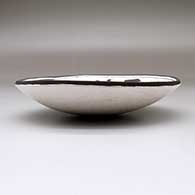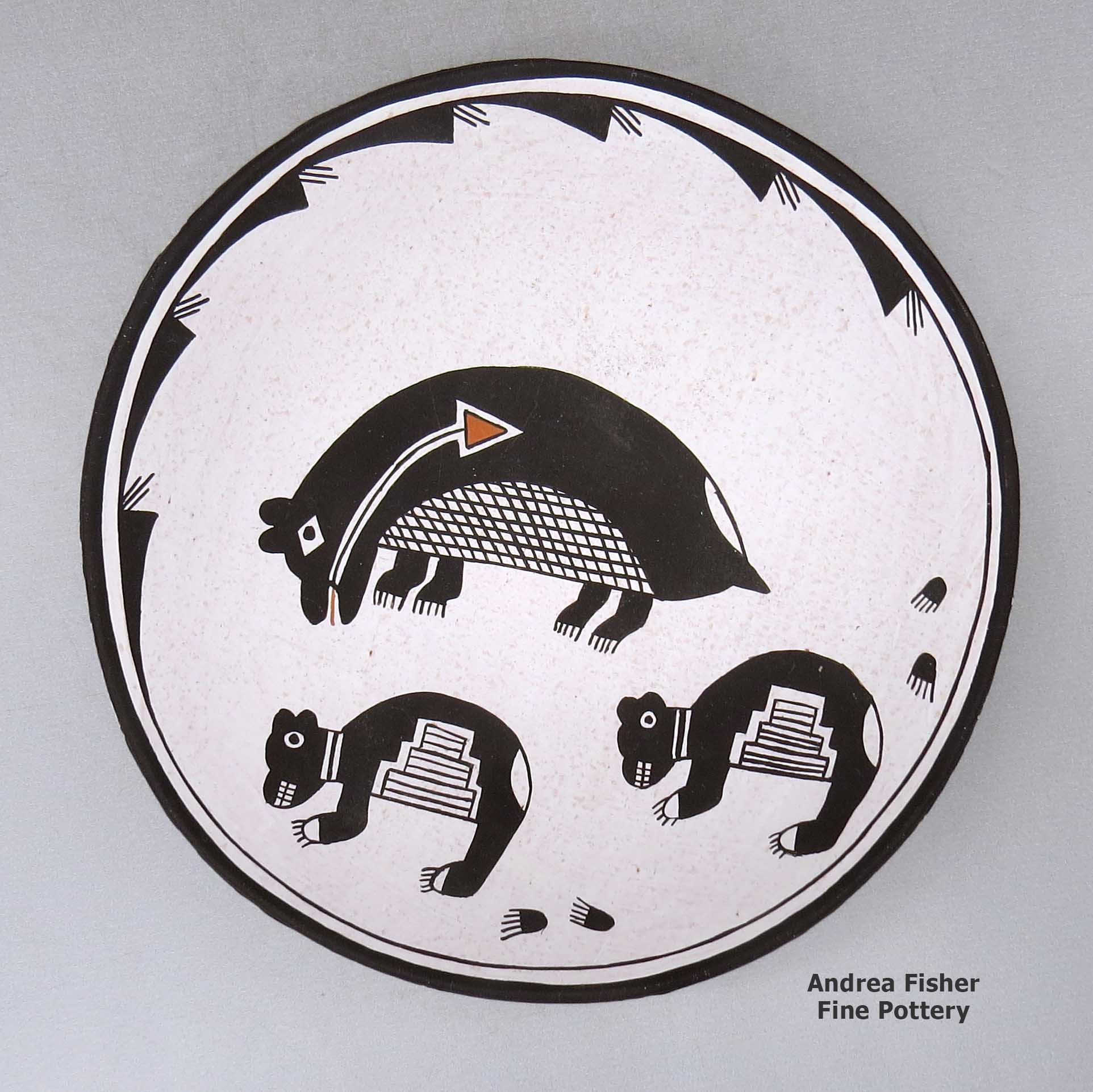
Click or tap to see a larger version
Emma Lewis, Acoma, An open, shallow polychrome bowl decorated with a Mimbres bear-with-heart-line and two cubs, plus a geometric design
Acoma
$ 425
rbac4j114
An open, shallow polychrome bowl decorated with a Mimbres bear-with-heart-line and two cubs, plus a geometric design
6.25 in L by 6.25 in W by 1.5 in H
Condition: Very good
Signature: Emma Lewis Acoma,
Tell me more! Buy this piece!
(505) 986-1234 - www.andreafisherpottery.com - All Rights Reserved
Emma Lewis
Acoma
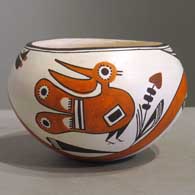
Emma Lewis was born into Acoma Pueblo on October 4, 1931, the daughter of Toribio Haskaya Luis and famous potter Lucy M. Lewis. She had six brothers and sisters and they all learned to make pottery from their mother.
Emma mostly made jars and seed pots, decorating them with Mimbres and Anasazi revival animals, birds, turtles, mountain sheep and rabbits. She also often decorated her pieces with parrots, berry bushes, split leaves and deer with heart lines.
Emma was a participant in the Santa Fe Indian Market from 1960 to 2001 and earned many ribbons there. Emma also traveled the world for 20 years, giving demonstrations and leading pottery making workshops, often with her sister, Dolores Lewis Garcia.
Emma passed on in 2013.
Acoma Pueblo

Sky City
According to Acoma oral history, the sacred twins led their ancestors to "Aaku," a magical mesa composed mostly of white rock, and instructed those ancestors to make that mesa their home. Acoma Pueblo is called "Sky City" because of its position atop the mesa. Acoma is located about 60 miles west of Albuquerque.
According to some archaeologists, a large group of Keres-speaking people left the Chaco Canyon area in the late 900s. They headed south, around the west side of the Mount Taylor volcano and across the Rio San Jose to Aaku, where they merged into a pueblo of people already living there.
Acoma, Old Oraibi (at Hopi) and Taos all lay claim to being the oldest continuously inhabited community in the U.S. Those competing claims are hard to settle as each village can point to archaeological remnants close by to substantiate each village's claim. While the people of Acoma have an oral tradition that says they've been living in the same area for more than 2,000 years, some archaeologists feel more that the present pueblo was established near the end of the major migrations of the 1200s and 1300s. The location is essentially on the boundary between the Mimbres-Mogollon to the south and west, and Ancestral Puebloan cultures to the north and east. Each of those cultures has had an impact on the styles and designs of Acoma pottery, especially since modern potters have been getting the inspiration for many of their designs from ancient potsherds they have found while walking on pueblo lands.
Francisco Vasquez de Coronado ascended the cliff to visit the Acomas in 1540. He afterward wrote that he "repented having gone up to the place." But the Spanish came back again, and kept coming back. In 1598 relations between the Spanish and the Acomas took a really bad turn with the arrival of Don Juan de Oñaté and the soldiers, settlers and Franciscan monks that accompanied him. After ascending to the mesa top, Oñaté decided to force the Acomas to swear loyalty to the King of Spain and to the Pope. When the Acomas realized what the Spanish meant by that, a group of Acoma warriors attacked a group of Spanish soldiers and killed 11 of them, including one of Oñaté's nephews.
Don Juan de Oñaté retaliated by attacking the pueblo, burning most of it and killing more than 600 people. Another 500 people were imprisoned by the Spanish: males between the ages of 12 and 25 were sold into slavery and 24 men over the age of 25 had their right foot amputated. Many of the women over the age of 12 were also forced into slavery and were eventually parceled out among Catholic convents in Mexico City. Two Hopi men also captured at Acoma had one hand cut off. Then they were released and sent home to spread the word about Spain's resolve to subjugate the inhabitants of Nuevo Mexico.
When word of the massacre and the punishments meted out got back to King Philip in Spain, he banished Don Juan de Oñaté from Nuevo Mexico. Some Acomas had escaped that fateful Spanish attack and returned to the mesa top in 1599 to begin rebuilding. In 1620 a Royal Decree was issued establishing civil offices in each pueblo, and Acoma had its first governor appointed. Those governors met at Santo Domingo Pueblo at the All Pueblos Council, the first democratic institution in the Americas, an institution that is still functioning.
By 1680, the situation between the pueblos and the Spanish had deteriorated to the point where the Acomas were extremely willing participants in the 1680 Pueblo Revolt. After the successful Pueblo Revolt, the Spanish retreated to Mexico. Refugees from other pueblos began arriving at Acoma, fearing an eventual Spanish return and reprisals. That strained the resources of Acoma until the Spanish actually did return. Then residents of the pueblo had to make a difficult decision. Many of the refugees chose to try a peaceful solution: they relocated to the ancient Laguna area and made peace with the Spanish as soon as they appeared in the region. Acoma made peace with the Spanish soon after.
Over the next 200 years, Acoma suffered from outbreaks of smallpox and other European-introduced diseases to which they had no natural immunity. They also sided with the Spanish against raiders from the Navajo and Apache tribes. Then New Mexico changed hands a couple times, the railroads arrived and, like every other Native American pueblo, the Acoma people became dependent on inexpensive goods brought in from the outside world.
For many years the villagers were content on the mesa top and they kept advances in technology below. Now most live in villages on the valley floor where water, electricity, natural gas and other "luxuries" are easily available. While a few families still make their permanent home on the mesa top, the old pueblo is used almost exclusively for ceremonies and celebrations these days.
Historically, Acoma was known for large, thin-walled "ollas," jars used for storing food and water. With the arrival of the railroad and tourists in the 1880s, Acoma potters adapted the size, shapes and styles of their pots in order to appeal to the new buyers.
Up into the mid-1960s, most Acoma potters felt it was an inappropriate display of ego to sign their pots. Then Kenneth Chapman convinced Lucy Lewis, Jessie Garcia and Marie Z. Chino of the value of their signatures and they started signing their pieces. The 1960s is also a time when the primary Acoma white clay vein passed through a layer of widely distributed impurities, impurities that passed through the clay filtering process and showed up only during and after the firing. The problem was so bad it affected virtually every Acoma potter and every pot they made. Thankfully, by the late 1960s they had burrowed through that layer of clay and into a deeper layer that didn't have the problem.



Acoma Pueblo at Wikipedia
Pueblo of Acoma official website
Pueblos of the Rio Grande, Daniel Gibson, ISBN-13:978-1-887896-26-9, Rio Nuevo Publishers, 2001
Upper photo courtesy of Marshall Henrie, Creative Commons Attribution-Share Alike 3.0 Unported License
Mimbres Pottery
Mimbres Mogollon Culture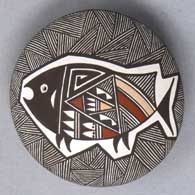
Rebecca Lucario
Acoma

Verda Toledo
Jemez
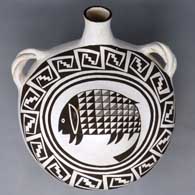
Marie Z. Chino
Acoma
The Mimbres Mogollon culture was named for the Mimbres River in the Gila Mountains. They lived in the area from about 850 CE to about 1150 CE. Substantial depopulation of the area occurred but there were many small surviving populations. Over time, these melted into the surrounding cultures with many families moving north to Acoma, Zuni and Hopi while others moved south to Casas Grande and Paquimé.
The time period from about 850 CE to about 1000 CE is classed the Late Basketmaker III period. The time period was characterized by the evolution of square and rectangular pithouses with plastered floors and walls. Ceremonial structures were generally dug deep into the ground. Local forms of pottery have been classified as early Mimbres black-on-white (formerly Boldface Black-on-White), textured plainware and red-on-cream.
The Classic Mimbres phase (1000 CE to 1150 CE) was marked with the construction of larger buildings in clusters of communities around open plazas. Some constructions had up to 150 rooms. Most groupings of rooms included a ceremonial room, although smaller square or rectangular underground kivas with roof openings were also being used. Classic Mimbres settlements were located in areas with well-watered floodplains available, suitable for the growing of maize, squash and beans. The villages were limited in size by the ability of the local area to grow enough food to support the village.
Pottery produced in the Mimbres region is distinct in style and decoration. Early Mimbres black-on-white pottery was primarily decorated with bold geometric designs, although some early pieces show human and animal figures. Over time the rendering of figurative and geometric designs grew more refined, sophisticated and diverse, suggesting community prosperity and a rich ceremonial life. Classic Mimbres black-on-white pottery is also characterized by bold geometric shapes but done with refined brushwork and very fine linework. Designs may include figures of one or multiple humans, animals or other shapes, bounded by either geometric decorations or by simple rim bands. A common figure on a Mimbres pot is the turkey, another is the thunderbird. There are also a lot of different fish depicted, some are species found in the Gulf of California.
A lot of Mimbres bowls (with kill holes) have been found in archaeological excavations but most Mimbres pottery shows evidence it was actually used in day-to-day life and wasn't produced just for burial purposes.
There's a lot of speculation as to what happened to the Mimbres people as their countryside was rapidly depopulated after about 1150 CE. The people of Isleta, Acoma and Laguna find ancient Mimbres pot shards on their pueblo lands, indicating that pottery designs from the Mimbres River area migrated north. There are similar designs found on pot shards littering the ground around Casas Grandes and Paquime near Mata Ortiz and Nuevo Casas Grandes in northern Mexico. Other than where they went, the only reasons offered for why they left involve at least small scale climate change. The usual comment is "drought" but drought could have been brought on by the eruption of a volcano on the other side of the planet, or a small change in the El Nino-La Nina schedule. Whatever it was that started the outflow of people, it began in the Mimbres River area and spread outward from there. Excavations in the Eastern Mimbres region (nearer to Truth or Consequences, New Mexico) have shown that the people adapted to new circumstances and that adaptation itself moved them closer into alignment with surrounding tribes and cultures. Eventually they just kind of merged into the background, although the groups that moved south and built up Paquime and Casas Grandes seem to have lost a war and survivors migrated to the west, to a land a bit more hospitable for them.
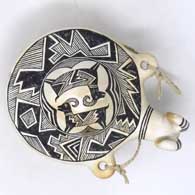
Michael Kanteena
Laguna
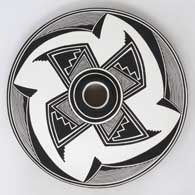
Paula Estevan
Acoma

Franklin Tenorio
Santo Domingo
Lucy Lewis Family Tree
Disclaimer: This "family tree" is a best effort on our part to determine who the potters are in this family and arrange them in a generational order. The general information available is questionable so we have tried to show each of these diagrams to living members of each family to get their input and approval, too. This diagram is subject to change should we get better info.
- Andrew H. Drew Lewis (1927-2005)
- Andrew H. Lewis Jr.
- Theodore Lewis
- Ann Lewis Hansen (1925-)
- Carmel Lewis Haskaya (1947-2019)
- Katarina Haskaya Lukee (1984-2015)
- Dolores Lewis Garcia (1938-)
- Emma Lewis Mitchell (1931-2013)
- Ivan Lewis (1919-2001) & Rita Lewis (Cochiti)(1920-1990)
- Mary Lewis Garcia (1933-2015)
Lucy Martin Lewis (c. 1900-1992) & Toribio Haskaya
Some of the above info is drawn from Southern Pueblo Pottery, 2000 Artist Biographies, by Gregory Schaaf, © 2002, Center for Indigenous Arts & Studies
Other info is derived from personal contacts with family members and through interminable searches of the Internet and cross-examination of the data found.
Copyright © 1998-2025 by



